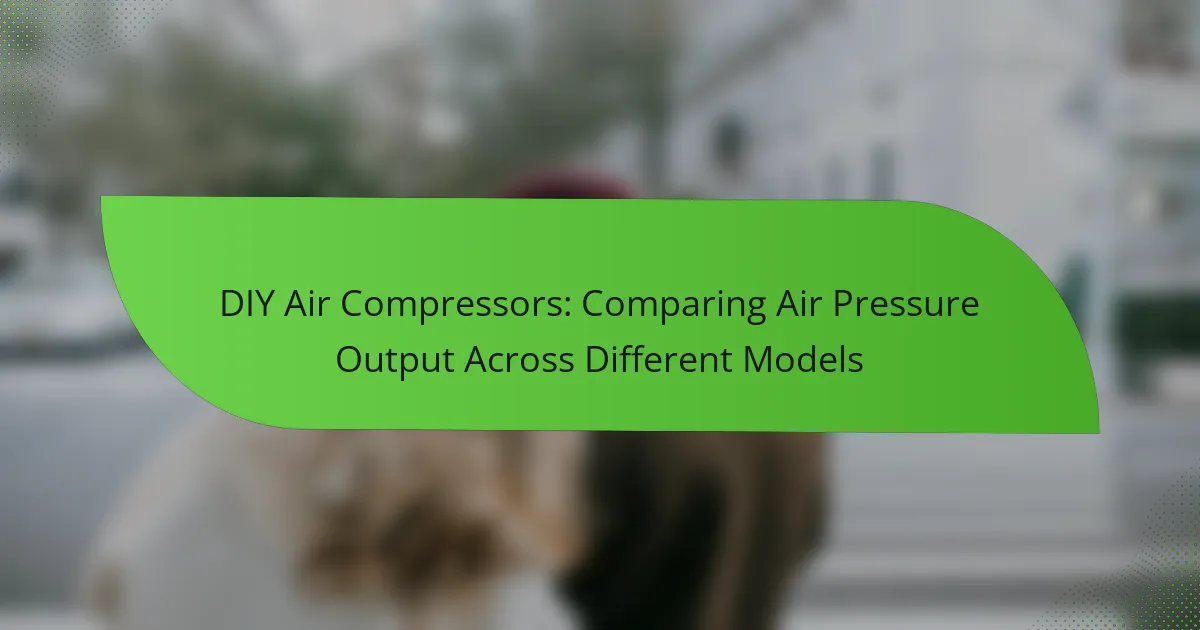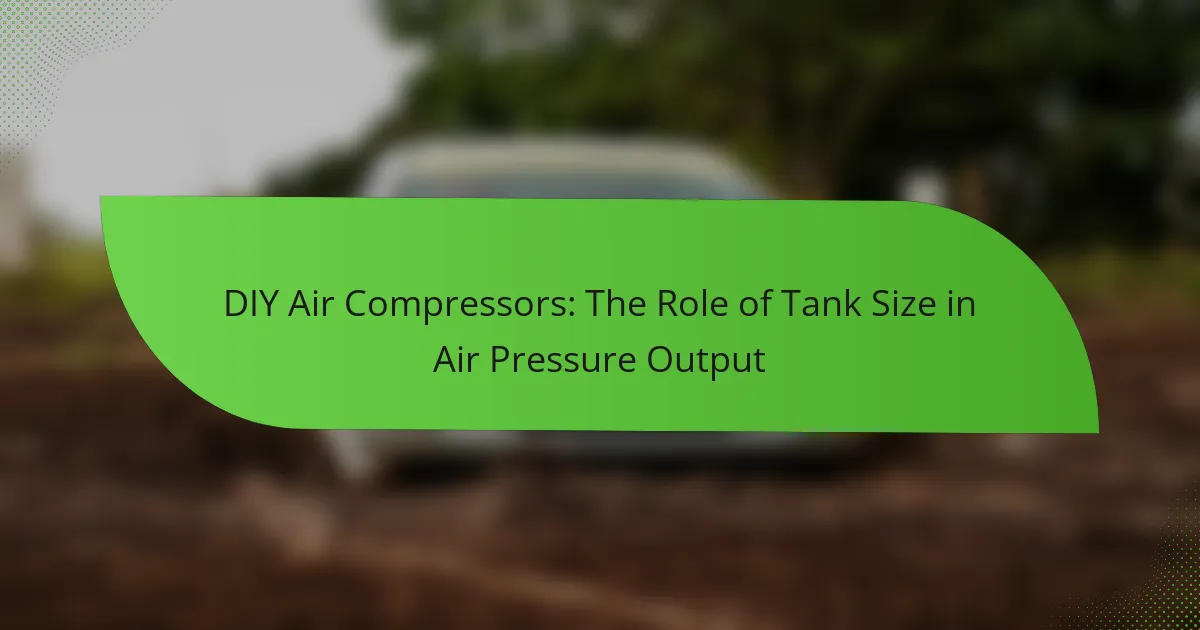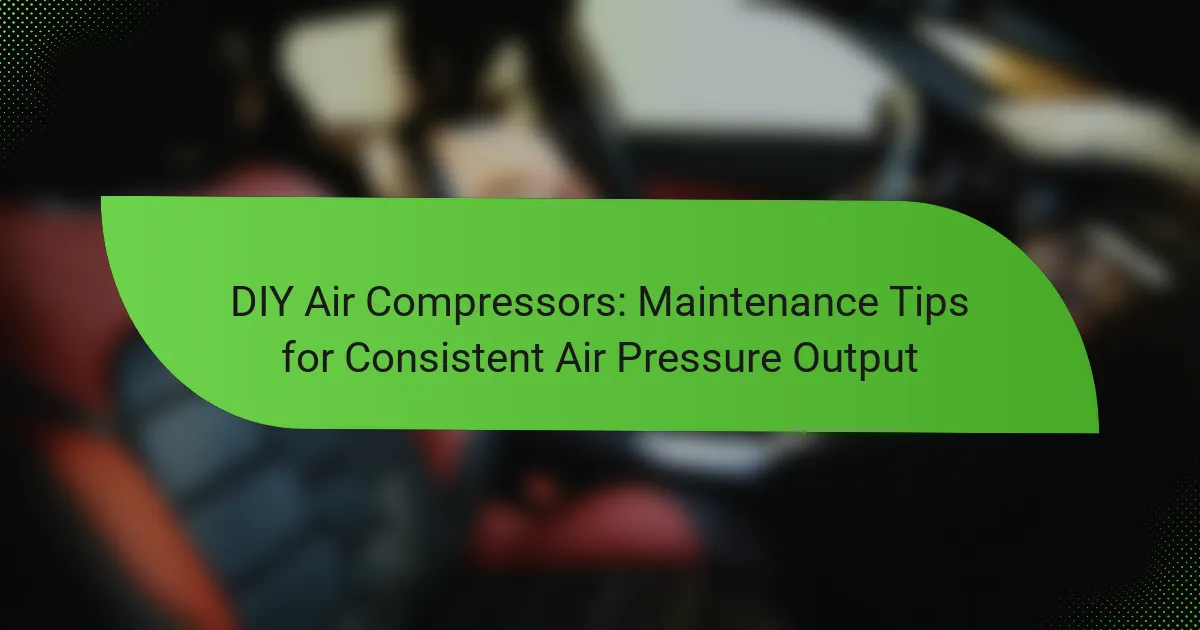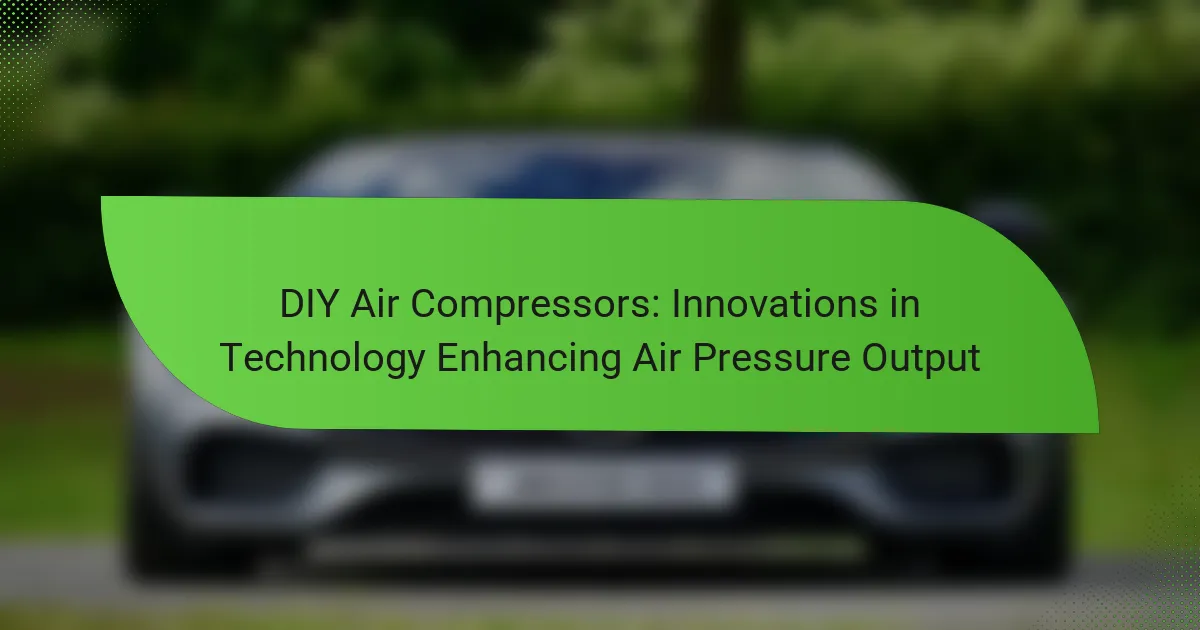DIY air compressors are homemade devices that generate compressed air for various applications, constructed from readily available materials and tools. They typically consist of a motor driving a pump that compresses air into a storage tank, enabling the use of compressed air for tasks such as powering tools and inflating tires. The performance of these compressors is influenced by key factors including compressor type, motor power, tank size, and ambient temperature, which collectively affect air pressure output. Proper maintenance practices, such as checking air filters, ensuring tight connections, and monitoring temperature, are essential for optimizing efficiency and prolonging the lifespan of DIY air compressors. Understanding these elements is crucial for anyone looking to build or improve their own air compressor system.
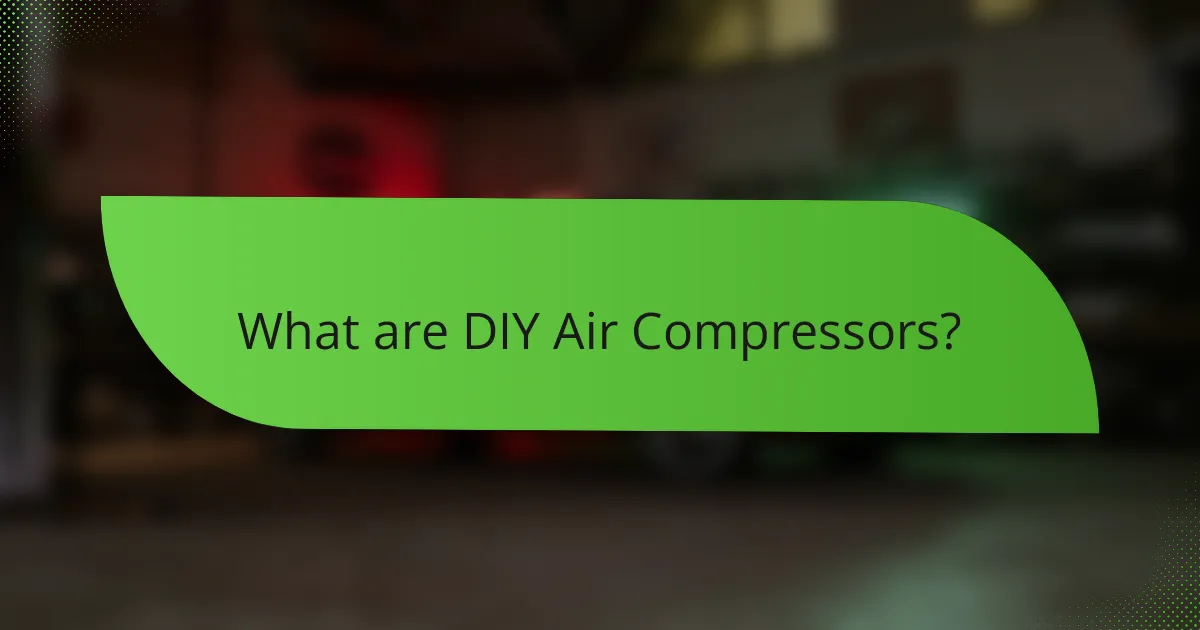
What are DIY Air Compressors?
DIY air compressors are homemade devices that generate compressed air for various applications. They can be constructed using readily available materials and tools. Commonly, they utilize a motor to drive a pump that compresses air into a storage tank. This compressed air can then be used for powering tools, inflating tires, or other tasks requiring pressurized air. The effectiveness of DIY air compressors depends on their design and components. For example, the size of the tank and the power of the motor directly influence air pressure output. Additionally, proper assembly and maintenance are crucial for optimal performance.
How do DIY Air Compressors function?
DIY air compressors function by converting mechanical energy into compressed air. They typically use an electric motor or a gasoline engine to drive a pump. The pump draws in ambient air and compresses it within a storage tank. This process increases the air pressure, allowing it to be stored for later use.
The compressed air can then be released through a valve for various applications. Common uses include powering pneumatic tools, inflating tires, and spraying paint. The efficiency of a DIY air compressor depends on the motor’s horsepower and the tank’s size.
For example, a larger tank can hold more compressed air, leading to longer usage without needing to refill. Proper maintenance, like checking for leaks, also ensures optimal performance.
What are the essential components of a DIY Air Compressor?
The essential components of a DIY air compressor include a motor, a pump, a tank, and a pressure switch. The motor provides the necessary power to drive the pump. The pump compresses the air and moves it into the tank. The tank stores the compressed air for later use. The pressure switch regulates the tank’s pressure by turning the motor on and off as needed. Additional components may include a pressure gauge, an air filter, and hoses for air delivery. These components work together to create a functional air compressor system.
How do these components interact to produce air pressure?
Air pressure is produced through the interaction of various components within a DIY air compressor. The primary components include the motor, pump, and storage tank. The motor powers the pump, which compresses air by reducing its volume. This compression increases the air’s density, resulting in higher pressure.
As the pump operates, it draws in ambient air and forces it into the storage tank. The tank serves as a reservoir, maintaining the pressure until the air is released. The pressure gauge monitors the air pressure within the tank, ensuring it remains at the desired level.
The efficiency of this process is influenced by the pump’s design and the motor’s power. A more powerful motor can compress air more quickly, leading to higher pressure output. Additionally, the quality of seals and fittings affects air leakage, which can reduce overall pressure.
These interactions are governed by the principles of physics, specifically Boyle’s law, which states that pressure and volume are inversely related. As the volume of air decreases during compression, the pressure increases, confirming the effectiveness of these components in producing air pressure.
Why are air pressure and performance critical in DIY Air Compressors?
Air pressure and performance are critical in DIY air compressors because they directly influence the efficiency and effectiveness of the tool. Higher air pressure allows for better power delivery to pneumatic tools. It ensures that tools operate at optimal levels, enhancing productivity. Performance is measured by the compressor’s ability to maintain consistent pressure during use. Inconsistent pressure can lead to tool malfunction or suboptimal results. Additionally, air compressors with higher performance ratings can handle more demanding tasks. This is essential for projects requiring sustained air supply. Therefore, understanding air pressure and performance is vital for successful DIY applications.
What factors influence air pressure output in DIY Air Compressors?
The factors that influence air pressure output in DIY air compressors include compressor design, motor power, and tank size. Compressor design affects efficiency and pressure generation capabilities. A more powerful motor increases the compressor’s ability to compress air effectively. Tank size determines the volume of air that can be stored, impacting the pressure output duration. Additionally, ambient temperature can affect air density, influencing pressure levels. The type of compressor, whether piston or rotary, also plays a role in the output pressure. Regular maintenance ensures optimal performance and consistent pressure output.
How does air pressure affect the performance of DIY Air Compressors?
Air pressure significantly impacts the performance of DIY air compressors. Higher air pressure increases the compressor’s efficiency in delivering compressed air. This efficiency is crucial for tasks such as powering pneumatic tools and inflating tires. Low air pressure can lead to underperformance, resulting in insufficient airflow for these applications. Additionally, the compressor’s design and capacity determine how effectively it can maintain desired air pressure levels. Consistent air pressure is essential for optimal tool operation and project completion. Research indicates that maintaining proper air pressure enhances tool longevity and performance reliability.
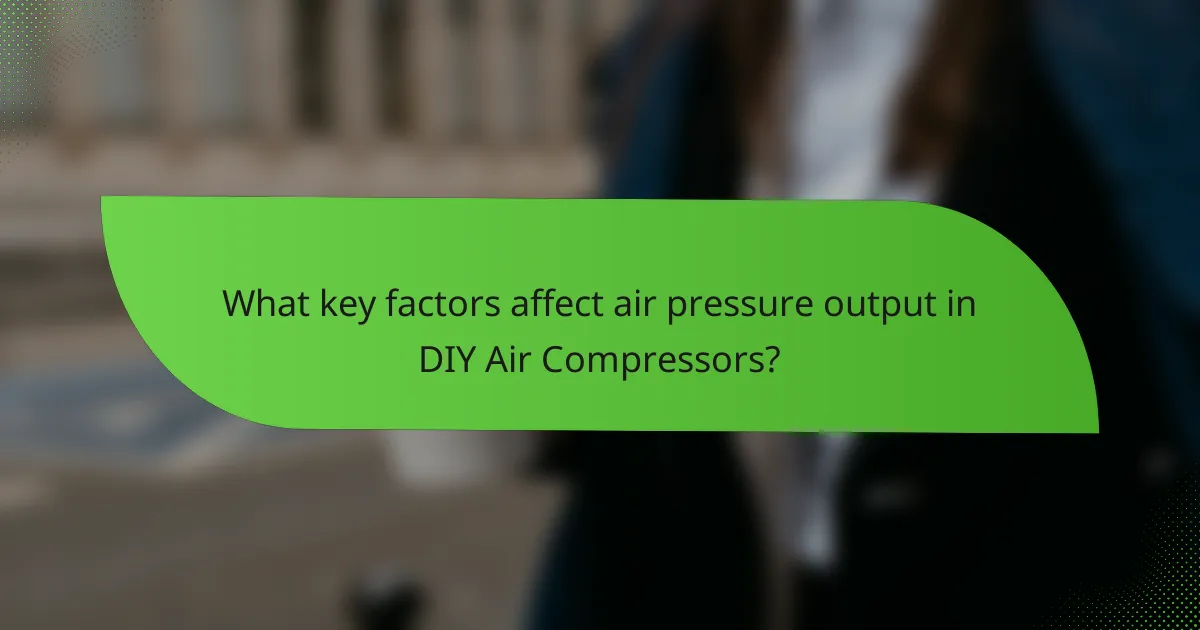
What key factors affect air pressure output in DIY Air Compressors?
The key factors affecting air pressure output in DIY air compressors include compressor type, motor power, tank size, and ambient temperature. Different compressor types, such as piston or diaphragm, produce varying pressure levels. Higher motor power typically leads to increased air pressure output. The size of the air tank influences the volume of compressed air available, impacting sustained pressure. Lastly, ambient temperature affects air density and can alter pressure readings. These factors collectively determine the efficiency and performance of DIY air compressors.
How does the size of the air tank influence air pressure?
The size of the air tank directly influences air pressure levels. A larger air tank can store more air, resulting in higher pressure. This is due to the relationship defined by Boyle’s Law, which states that pressure and volume are inversely related in a closed system. As the tank size increases, the volume of air available for compression also increases. Consequently, air compressors can maintain a more consistent pressure over extended periods. Smaller tanks deplete air faster, leading to rapid pressure drops during use. Therefore, tank size plays a crucial role in determining the efficiency and effectiveness of air pressure output in DIY air compressors.
What is the relationship between tank size and air delivery rate?
Tank size directly influences the air delivery rate of an air compressor. A larger tank can store more compressed air, allowing for a higher delivery rate over time. This means that tools requiring a consistent air supply can operate more efficiently. Conversely, a smaller tank may lead to frequent cycling of the compressor, reducing the overall air delivery rate. For example, a 20-gallon tank can deliver air at a rate of 5 CFM (cubic feet per minute) compared to a 2 CFM rate from a 5-gallon tank. Thus, the relationship between tank size and air delivery rate is significant; larger tanks generally support higher and more stable air delivery rates.
How does tank size impact the overall efficiency of the compressor?
Tank size directly impacts the overall efficiency of the compressor. A larger tank allows for a greater volume of compressed air to be stored. This reduces the frequency of the compressor cycling on and off. Consequently, it leads to more consistent air pressure output. A larger tank also minimizes energy consumption during operation. This is because the compressor runs less often, which saves electricity. According to studies, compressors with bigger tanks can operate at lower duty cycles. Lower duty cycles enhance the lifespan of the compressor. Therefore, tank size is a critical factor in determining compressor efficiency.
How do the motor specifications affect air pressure output?
Motor specifications directly influence air pressure output in compressors. The motor’s power rating determines the compressor’s ability to compress air efficiently. Higher power ratings enable the motor to generate greater torque. This increased torque allows for faster rotation of the compressor’s pump. Faster pump rotation leads to quicker air compression cycles. Additionally, motor speed affects the volume of air processed per minute. Higher speeds typically result in increased air pressure output. The type of motor, whether induction or brushless, also plays a role in efficiency and performance. Induction motors are generally more robust but may have slower response times compared to brushless motors. Overall, motor specifications are critical for optimizing air pressure output in DIY air compressors.
What is the significance of motor horsepower in air compressors?
Motor horsepower is significant in air compressors as it determines the compressor’s power output and efficiency. Higher horsepower ratings enable compressors to produce more air pressure and volume. This directly affects the performance in various applications, from powering tools to inflating tires. For instance, a 5 HP motor can typically deliver around 17 CFM at 90 PSI, which is suitable for heavy-duty tasks. Conversely, a lower horsepower motor may struggle to meet the demands of high-consumption tools. Thus, selecting the appropriate motor horsepower is crucial for optimal compressor performance and longevity.
How does motor speed influence air pressure generation?
Motor speed directly influences air pressure generation in compressors. As motor speed increases, the compressor’s ability to move air also rises. This leads to higher air pressure output. Research shows that a motor running at optimal speed can produce significantly greater pressure than one operating below that speed. For example, a motor designed for 3,600 RPM can generate up to 90 PSI, while one at 1,800 RPM may only reach 40 PSI. Therefore, maintaining appropriate motor speed is crucial for maximizing air pressure efficiency.
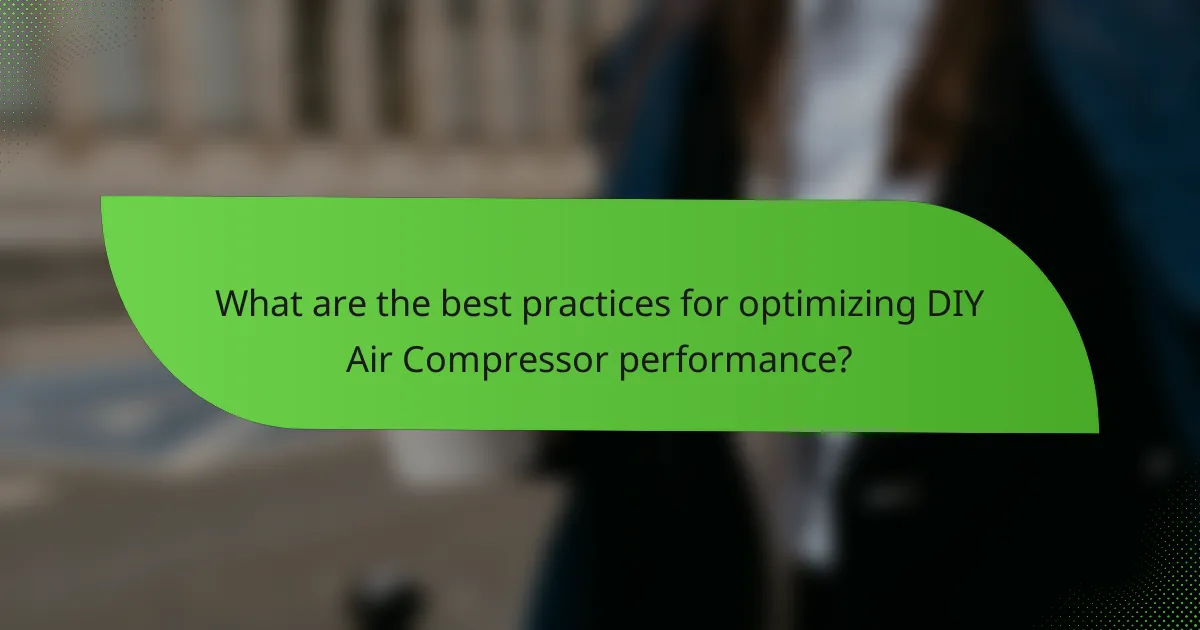
What are the best practices for optimizing DIY Air Compressor performance?
To optimize DIY air compressor performance, ensure proper maintenance and adjustments. Regularly check and replace air filters to maintain airflow efficiency. Keep the compressor clean to prevent debris buildup. Ensure all connections are tight to avoid air leaks. Use the correct oil type for lubrication, as recommended by the manufacturer. Adjust the pressure settings according to the specific task requirements. Monitor the temperature of the compressor to prevent overheating. These practices enhance efficiency and prolong the lifespan of the compressor.
How can maintenance improve air pressure output?
Regular maintenance can significantly improve air pressure output in compressors. This includes checking and replacing air filters. Clogged filters restrict airflow, reducing pressure. Additionally, lubricating moving parts ensures optimal performance. Proper lubrication decreases friction and wear, enhancing efficiency. Inspecting hoses and connections prevents leaks. Leaks can lead to pressure loss, impacting overall output. Cleaning the compressor tank removes moisture buildup. Moisture can cause rust and corrosion, affecting performance. Lastly, calibrating pressure settings ensures the compressor operates within optimal ranges. Consistent maintenance can lead to a 10-20% increase in air pressure output.
What routine checks should be performed on a DIY Air Compressor?
Routine checks for a DIY air compressor include inspecting the air filter, checking the oil level, and examining the hoses for leaks. The air filter should be clean to ensure optimal airflow. A low oil level can lead to engine damage, so it must be monitored regularly. Hoses should be free of cracks or wear to prevent air loss. Additionally, the safety valve should be tested to ensure it functions properly. Regularly checking these components can enhance the compressor’s performance and longevity.
How does proper lubrication affect compressor efficiency?
Proper lubrication significantly enhances compressor efficiency. It reduces friction between moving parts. This reduction in friction leads to lower energy consumption. As a result, the compressor operates more smoothly. Proper lubrication also minimizes wear and tear on components. This extends the lifespan of the compressor. Studies indicate that well-lubricated compressors can achieve up to 10% higher efficiency. Therefore, maintaining proper lubrication is essential for optimal performance.
What troubleshooting tips can help maintain optimal performance?
Regular maintenance is essential to maintain optimal performance of DIY air compressors. Check the air filter frequently and replace it if it is dirty. Clean the compressor’s exterior to prevent dust buildup. Inspect hoses and connections for leaks or wear. Ensure that the oil level is adequate for oil-lubricated models. Drain the moisture from the tank after each use to prevent rust. Verify that the pressure switch is functioning correctly to maintain proper air pressure. Follow the manufacturer’s guidelines for maintenance schedules and procedures. Regular maintenance can extend the lifespan of the compressor and enhance its efficiency.
How can you identify and fix common air pressure issues?
To identify and fix common air pressure issues, check for leaks in hoses and connections. Use soapy water to detect bubbles indicating leaks. Inspect the air filter for clogs that can restrict airflow. Clean or replace the filter if necessary. Ensure the pressure regulator is functioning properly. Adjust the regulator to achieve the desired pressure settings. Monitor the tank pressure gauge for accurate readings. If pressure drops unexpectedly, it may signal a malfunctioning compressor. Regular maintenance can prevent these issues. Keeping components clean and well-maintained ensures optimal performance.
What adjustments can be made to enhance compressor performance?
Adjustments to enhance compressor performance include optimizing the air intake system, maintaining proper lubrication, and ensuring adequate cooling. Improving the air intake system can increase airflow, which directly boosts efficiency. Regular lubrication reduces friction and wear, prolonging the compressor’s lifespan and enhancing performance. Adequate cooling prevents overheating, which can lead to reduced efficiency and potential damage. Additionally, adjusting the pressure settings to match the application requirements can optimize energy use. Regular maintenance checks, such as cleaning filters and inspecting hoses, also contribute to consistent performance. These adjustments are critical for achieving optimal air pressure output and overall efficiency in DIY air compressors.
DIY air compressors are homemade devices designed to generate compressed air for various applications, such as powering tools and inflating tires. This article explores the critical factors affecting air pressure output and performance, including compressor design, motor power, tank size, and maintenance practices. Key components like the motor, pump, and storage tank interact to produce air pressure, while proper maintenance can significantly enhance efficiency and output. Understanding these elements is essential for optimizing the functionality of DIY air compressors.
